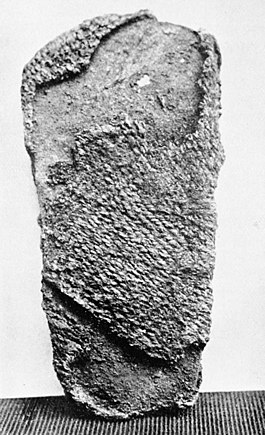sands of miles is still preserved on the academy's grounds. The other region archæologically explored by the academy is the local  Fig. 9.—Copper Axis wrapped in Cloth. field immediately around Davenport. In the investigations here some most important facts regarding mound construction and burial have been secured and curious and valuable relics found. Among these local relics are skulls, objects of shell, carved stone pipes, copper axes wrapped in cloth (the structure of which has been preserved by impregnation with salts of copper produced by atmospheric action), and stone tablets bearing inscriptions or pictorial designs. None of these relics have attracted so much attention as two of the stone pipes, called from their shape "elephant pipes," and the tablets, which are three in number, two of black slate and one of limestone. About the authenticity of these five objects a bitter controversy has waged. The matter first appeared within the academy August 29, 1884, when attention was called to an article by H. W. Henshaw in the Second Annual Report of the Bureau of Ethnology. In this article the authenticity of the elephant pipes was seriously impugned. A committee was appointed to look into the charge and meet it. A somewhat acrimonious discussion, in which many took part, was conducted in various periodicals. Mr. Charles E. Putnam, father of J. Duncan Putnam, and president of the academy, prepared a vindication, which was published as an independent pamphlet, and later republished with an appendix of congratulatory letters from various archaeologists. While this is not the proper place for discussing the authenticity of these specimens, it may not be out of place for the writer to say that to his judgment no substantial argument
Fig. 9.—Copper Axis wrapped in Cloth. field immediately around Davenport. In the investigations here some most important facts regarding mound construction and burial have been secured and curious and valuable relics found. Among these local relics are skulls, objects of shell, carved stone pipes, copper axes wrapped in cloth (the structure of which has been preserved by impregnation with salts of copper produced by atmospheric action), and stone tablets bearing inscriptions or pictorial designs. None of these relics have attracted so much attention as two of the stone pipes, called from their shape "elephant pipes," and the tablets, which are three in number, two of black slate and one of limestone. About the authenticity of these five objects a bitter controversy has waged. The matter first appeared within the academy August 29, 1884, when attention was called to an article by H. W. Henshaw in the Second Annual Report of the Bureau of Ethnology. In this article the authenticity of the elephant pipes was seriously impugned. A committee was appointed to look into the charge and meet it. A somewhat acrimonious discussion, in which many took part, was conducted in various periodicals. Mr. Charles E. Putnam, father of J. Duncan Putnam, and president of the academy, prepared a vindication, which was published as an independent pamphlet, and later republished with an appendix of congratulatory letters from various archaeologists. While this is not the proper place for discussing the authenticity of these specimens, it may not be out of place for the writer to say that to his judgment no substantial argument
Page:Popular Science Monthly Volume 51.djvu/100
Jump to navigation
Jump to search
92
POPULAR SCIENCE MONTHLY.
